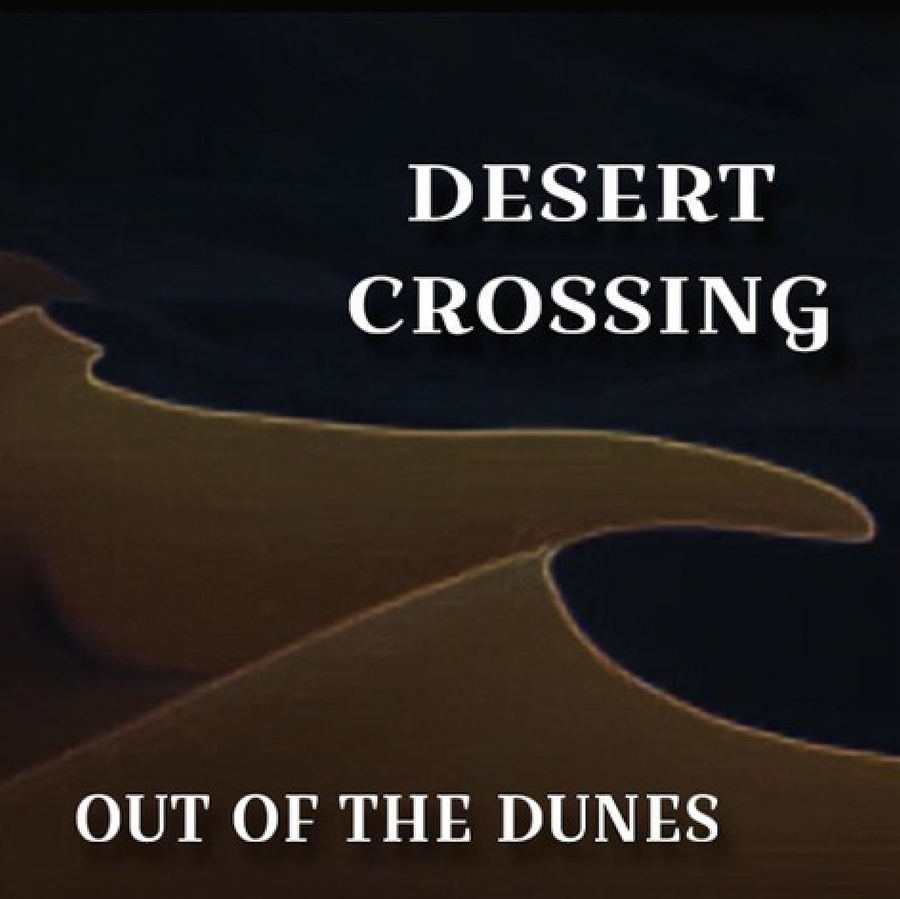CD Reviews
DESERT CROSSING: Out of the Dunes

Desert Crossing is ordinarily the duo made up of Michael J. Dwyer and Rose Darrough when they play out around town. For Out of the Dunes, they brought in additional players, amped it up, and filled out the arrangements. All 14 songs, running just over 56 minutes, were written by the two of them, Darrough primarily as the lyricist and Dwyer wrote the melodies.
Engineered by Jerry Brown at Charing Cross Studios in Spring Valley, all instruments were recorded live, and so, there is that open, spontaneous feel that comes from vibing and grooving together. Olivia Taylor on drums has a beefy yet refined style; Larry Clark on bass is steady and innovative; Kim Weeks especially shines on slide guitar, over and over again; and Steve Dame plays banjo on “Imperial County Line.” Besides guitar, Dwyer also plays harmonica, and he and Darrough both take turns singing lead vocals and harmonies. Who sings what and when seems to have been planned well, and they are each relatively strong in both roles.
The project was mixed and mastered by Jerry Brown and Eric Uglam at New Wine Studios. All in all, they did a great job, it’s well balanced and crisp. I found it easy to hear the lyrics and still enjoy the instrumentation.
Lyrically, the songs have a tendency to be repetitive, often using final verse lines to lead into the same lines used for repeating chorus lines. As solid as the ideas are, I am looking for more depth and intricacy in the execution of those ideas. The arrangements and the full-band production have merit, but I can’t help but think, as this is a fairly new collaboration, that Darrough will continue to grow in her abilities, and, along with Dwyer’s years of talent and expertise, it will all end up rock solid.
Slide guitar swaggers and sways dirty on the intro to “Crime by Design” and sets a dark stage for a dark topic. As Darrough begins to sing, she plays it emotional and raw; it suits her well. The slide rides her notes along with her to accentuate the tension. “Johnny tried it straight, worked his fingers to the bone. Stayed in bed one day, took stock of all he owned. Thought he could do better than a broken, one-room shack. Got himself a gun and planned to find the things he lacked.” The chorus breaks through the anxiety as the band joins in and sets in motion the events of a day in the life of a man at the end of his rope. “It was a crime by design, he was well rehearsed. All was in place, but his day was cursed. It was a crime by design, all the Ts were crossed, till his fate took over and everything was lost.” The rhythm remains upbeat as Dwyer sings the next two verses, and it is now matter of fact that crime doesn’t pay and Johnny will suffer for it. At 2:55, the slide and electric guitar trade solo lines back and forth as they paint a picture of the chaos, and we know it will not end well. And, in fact, his plans to rob a bank and go to Peru, culminate in a car crash instead, and that driving, insistent rhythm seems to mock Johnny in that failed ambition.
Open and bare, the arrangement for “Slidin’” is stripped down to vocals with Dwyer fingerpicking on acoustic guitar that evokes a style reminiscent of late ’70s Fleetwood Mac. Darrough takes the lead vocals for the whole song and I feel her story. It is melancholic but also hopeful. She sings each line with angst and meaning; however, I am distracted by uneven and varied rhyming conventions. The first four lines all loosely rhyme; in the next set, only lines two and four do; then in the rest of the song it is lines one and two, and three and four. This is where I think time and more experience will help her to hone her delivery, to make her message more readily accessible. There is a lovely melodic rise with the chorus and Dwyer joins her singing harmony. It is this change that holds the feeling of hope, she even states it, “Change for the better, change for the worst. Change to stay the same. Change to avoid blame.”
“I’m All In” has got a shuffling, groovy beat. The drums are steady with what sounds like brushes on the snare, the slide guitar moves languidly; Darrough sings simple lines in the same manner. Dwyer backs her on the chorus and I hear an urgency in their voices together. “I’m all in, this is where I am. I’m all in, give me what you can. I’m standing next to you, where I want to land. I’m all in, this is where I am.” At 1:01 the slide comes in with a smooth solo, it is a wave that carries the song forward. We hear another verse and chorus followed by another short slide solo at 1:57… what a treat. Even though it has a slower tempo, the song moves steadily along; it’s that coupling of the snare and slide guitar, though, that really makes it for me; they’ve got chemistry.
A lone acoustic guitar strums and picks sparingly to begin “I Can See.”” It goes through a progression twice, becoming more complex until Dwyer, with a voice like gravel and silk, sings achingly, “I can see how you wear your pain, the tears you let fall, start slow and then rain.” Darrough sings the next line, “I can see love still shines through regret in your eyes to last a lifetime.” Although they trade off taking the vocal lead, it is Dwyer who really shines on this one. It’s the very embodiment of longing and sorrow. The drums and slide come in at the chorus, with Darrough backing Dwyer on harmony. There is some dissonance between their voices in the first line, but it smooths out in subsequent lines. The slide is more prominent behind the second verse and builds, along with the drums, toward the next chorus. At 2:11, the slide solos become punchier, more ambitious and bolder, playing in octaves, until ending quietly in harmonics, nice choices. Each chorus is bigger, epic even, until finally, it quickly drops out and ends. This one is my favorite.
There are ten more songs worth hearing, among them is the upbeat driving rhythm of “One Eyed Eighteen Wheeler,” the ’60s retro vibe of “Analog Player” and the swing feel of “Feral Cat.” The album is available on CD and all streaming platforms.








